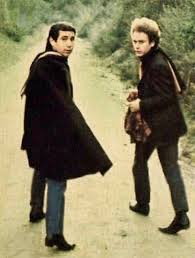I assume many of you are familiar with Simon & Garfunkel’s songs The Sound of Silence and Mrs. Robinson. I love these songs, too, but they do not even scratch the surface of the heavenly pool of pieces produced by this powerful duo. I often just read Simon & Garfunkel songs without any music because their lyrics can stand as poetry on their own. Combined with complex acoustic guitar fingerings and mind-blowing harmonies, Simon & Garfunkel’s beautiful words create thought-provoking, inspiring, and enlightening songs.
One of my favorite pieces by Simon & Garfunkel is The Dangling Conversation. I could not bring myself to pick just one section to share with you, so here is the full song:
It’s a still life water color,
Of a now late afternoon,
As the sun shines through the curtained lace
And shadows wash the room.
And we sit and drink our coffee
Couched in our indifference,
Like shells upon the shore
You can hear the ocean roar
In the dangling conversation
And the superficial sighs,
The borders of our lives.
And you read your Emily Dickinson,
And I my Robert Frost,
And we note our place with bookmarkers
That measure what we’ve lost.
Like a poem poorly written
We are verses out of rhythm,
Couplets out of rhyme,
In syncopated time
Lost in the dangling conversation
And the superficial sighs,
Are the borders of our lives.
Yes, we speak of things that matter,
With words that must be said,
“Can analysis be worthwhile?”
“Is the theater really dead?”
And how the room is softly faded
And I only kiss your shadow,
I cannot feel your hand,
You’re a stranger now unto me
Lost in the dangling conversation.
And the superficial sighs,
In the borders of our lives.
The music in The Dangling Conversation is rather simple and quiet, but the lyrics expose Simon & Garfunkel’s creative genius. I believe this song tells the story of two people falling out of love. There is an important conversation to have that neither person is willing to bring up, and so it becomes “the dangling conversation” that rips them apart.
The idea presented in the very first line: “It’s a still life water color,” intrigued me. Water color is a form of painting where precision does not matter. In fact, the whole point of water color is to have soft edges, mixed colors, and a more impressionistic appearance. Still life is the exact opposite. The point of still life painting is to portray stationary items (usually something mundane like a bowl of fruit or candles on a table) as accurately as possible. I think Simon & Garfunkel use the juxtaposition of “a still life water color” to express the tragic paradox in the lovers’ relationship. Where they should have clarity, they have obfuscation. The “dangling conversation” causes their still life relationship to become blurred like a water color.
The lines “and the superficial sighs/ the borders of our lives” repeats throughout the song. Through these words, the listener can easily see two lovers sitting in the same room…no speaking, only the occasional unnoticed sigh. These sighs are superficial because they convey no meaning to the other person. Whereas a lover in a thriving relationship would hear his or her partner sigh and ask what was wrong, these lovers simply ignore the sighs and accept them as the “border.” Neither lover asks what is wrong because they both know. They refuse to talk about the “dangling conversation,” and so accept the occasional sigh as the limit.

